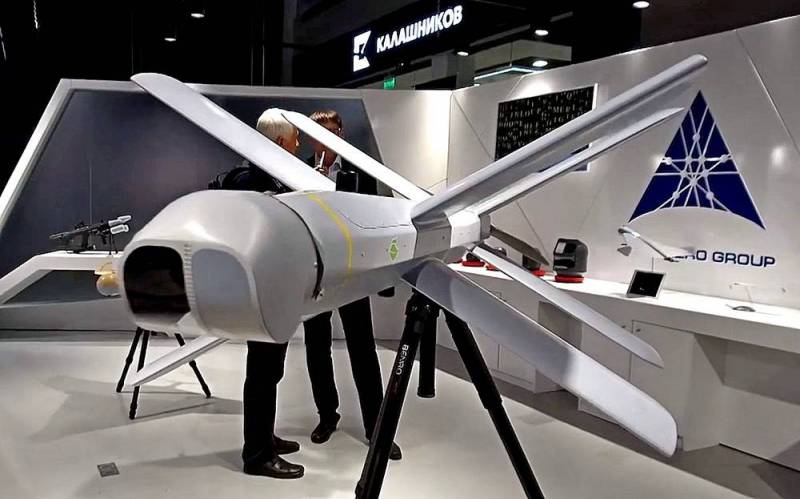Urban battles in Ukraine showed the demand for kamikaze drones "Lancet" and "Cube"
We continue to reveal the topic of what kind of unmanned aerial vehicles the Russian army needs. The special military operation for the demilitarization and denazification of Ukraine revealed a number of serious problems in the RF Armed Forces, one of which is an acute shortage of UAVs. It got to the point that in order to strike at the enemy, our military had to improvise and use the initially purely reconnaissance Orlans-10 as the carrier of the warhead. Without the massive use of drones for reconnaissance and target designation, it is already difficult to fight today.
As we have have established Earlier, the main "workhorse" of the Russian army in the near future should be the medium-altitude UAV "Orion", the production plant of which was opened last year. Initially reconnaissance, it was modified in order to carry up to 6 bombs or 4 anti-tank missiles on a suspension. The drone was successfully tested in Syria, delivering missile and bomb strikes against terrorists, and is as ready for serial production as possible. It is also known about cases of successful use of Orion during a special operation in Ukraine. The American edition of The National Interest commented on this experience as follows:
Although the appearance of the Orion drone demonstrates the Russian technological progress, it does not yet play a fundamental role in Russian military operations.
The reason is simple - there are still very few of these UAVs so that they can somehow radically affect the course of hostilities.
Another drone that is undoubtedly eagerly awaited by the Russian troops is the Altius-U long-range reconnaissance and strike UAV. Being in the air for up to two days in a row, this aircraft could control the movement of enemy troops using the “toad jumping” tactic, strike it on its own and give data for target designation to other drones, the so-called kamikaze. The latter needs to be discussed in more detail.
"Lancets" and "Cube"
A special kind of UAVs are "kamikaze" drones with an integrated warhead, which are, in fact, a hybrid of a drone and an aerial bomb. Once released, such a drone is capable of loitering in the air for a long time, waiting for the operator’s command to attack and detonate, dying along with the target. It is known that the United States supplied the Armed Forces with more than a hundred Switchblade kamikaze drones, which were immediately dubbed “killers of Russian generals” in the Ukrainian press. This, of course, is hype, but the danger posed by loitering ammunition cannot be overestimated.
Israel is considered a recognized leader in this area, while Russia has taken up this only in recent years. The first developments were demonstrated at the IDEX 2019 exhibition in the United Arab Emirates by ZALA AERO, which is part of the Kalashnikov defense concern. It is known about two promising domestic kamikaze drones.
The first is the Lancet-1 and Lancet-3 family of UAVs, created according to a rather atypical scheme: one large X-shaped wing and a smaller X-shaped plumage in the tail. This design and the widespread use of composite materials made it possible to reduce the size and weight of the drone, as well as significantly increase the flight time and the speed of maneuvering and diving to the target. The mass of the warhead is 1 kilogram for the younger version and 3 for the older one. The power plant that sets the UAV in motion is electric. The integrated reconnaissance, navigation and communications module is responsible for target designation.
Another promising kamikaze drone is the small-sized Cube drone, made according to the “flying wing” scheme. Structurally, it is close to the American Switchblade. The Russian UAV is made of composite materials that reduce weight and make it difficult to detect by air defense systems, can stay in the air for up to 30 minutes and move at speeds up to 80-130 km/h. The drone is launched discreetly thanks to the electric motor, flies silently, and is easy to operate. The attack takes place using the vertical dive method, which allows a small UAV to penetrate even a tank turret. If necessary, the "Cube" can self-destruct or descend by parachute.
Obviously, such loitering munitions, capable of hitting targets with surgical precision, would be extremely in demand during urban battles in Ukraine. As you know, Russian troops try to avoid unnecessary destruction and casualties to the maximum, while Ukrainian troops, on the contrary, prefer to hide behind their fellow citizens as a human shield, placing armored vehicles and artillery close to residential buildings, kindergartens, hospitals and schools. If the Armed Forces of the Russian Federation had a sufficient number of Lancets, the Armed Forces of Ukraine would have had a very difficult time, and the effectiveness of such tactics would have dropped significantly.

Information